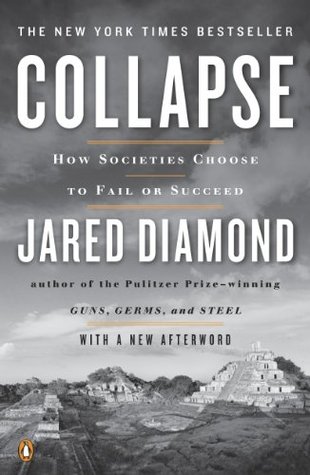More on this book
Community
Kindle Notes & Highlights
Read between
December 14 - December 29, 2019
10. Human activities produce gases that escape into the atmosphere, where they either damage the protective ozone layer (as do formerly widespread refrigerator coolants) or else act as greenhouse gases that absorb sunlight and thereby lead to global warming.
The remaining two problems involve the increase in human population:
11. The world’s human population is growing.
12. What really counts is not the number of people alone, but their impact on the environment.
the biggest problem is the increase in total human impact, as the result of rising Third World living standards, and of Third World individuals moving to the First World and adopting First World living standards.
Even if the human populations of the Third World did not exist, it would be impossible for the First World alone to maintain its present course, because it is not in a steady state but is depleting its own resources as well as those imported from the Third World.
Our world society is presently on a non-sustainable course, and any of our 12 problems of non-sustainability that we have just summarized would suffice to limit our lifestyle within the next several decades. They are like time bombs with fuses of less than 50 years.
The only question is whether they will become resolved in pleasant ways of our own choice, or in unpleasant ways not of our choice, such as warfare, genocide, starvation, disease epidemics, and collapses of societies.
the value of “one statistical life” in the U.S.—i.e., the cost to the U.S. economy resulting from the death of an average American whom society has gone to the expense of rearing and educating but who dies before a lifetime of contributing to the national economy—is usually estimated at around $5 million.
All of our current problems are unintended negative consequences of our existing technology. The rapid advances in technology during the 20th century have been creating difficult new problems faster than they have been solving old problems:
the amounts of CFCs already in the atmosphere are sufficiently large, and their breakdown sufficiently slow, that they will continue to be present for many decades after the eventual end of all CFC production.
one of the main lessons to be learned from the collapses of the Maya, Anasazi, Easter Islanders, and those other past societies (as well as from the recent collapse of the Soviet Union) is that a society’s steep decline may begin only a decade or two after the society reaches its peak numbers, wealth, and power.
The reason is simple: maximum population, wealth, resource consumption, and waste production mean maximum environmental impact, approaching the limit where impact outstrips resources.
Data on national wealth demonstrate that the claim that more people mean more wealth is the opposite of correct.
as an empirical fact, more people and a higher population growth rate mean more poverty, not more wealth.
highest blood levels of toxic industrial chemicals and pesticides reported for any people in the world are for Eastern Greenland’s and Siberia’s Inuit people (Eskimos), who are also among the most remote from sites of chemical manufacture or heavy use.
Why should levels of these poisonous chemicals from remote industrial nations of the Americas and Europe be higher in the Inuit than even in urban Americans and Europeans? It’s because staples of the Inuit diet are whales, seals, and seabirds that eat fish, molluscs, and shrimp, and the chemicals become concentrated at each step as they pass up this food chain.
that doesn’t mean that you will be safe if you stop eating seafood, because you now can’t avoid ingesting such chemicals no matter what you eat.)
We are so dependent on the rest of the world that if, 30 years ago, you had asked a politician to name the countries most geopolitically irrelevant to our interests because of their being so remote, poor, and weak, the list would surely have begun with Afghanistan and Somalia, yet they subsequently became recognized as important enough to warrant our dispatching U.S. troops.
societies today are so interconnected that the risk we face is of a worldwide decline.
The whole world today is a self-contained and isolated unit, as Tikopia Island and Tokugawa Japan used to be. We need to realize, as did the Tikopians and Japanese, that there is no other island/other planet to which we can turn for help, or to which we can export our problems. Instead, we need to learn, as they did, to live within our means.


